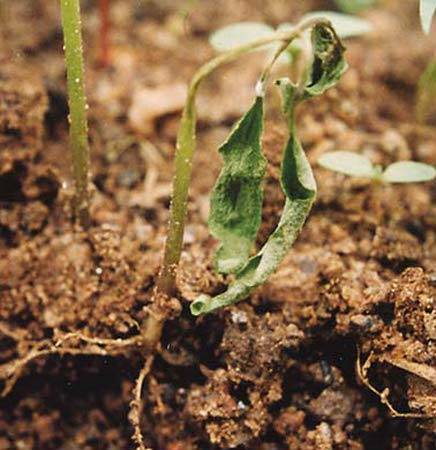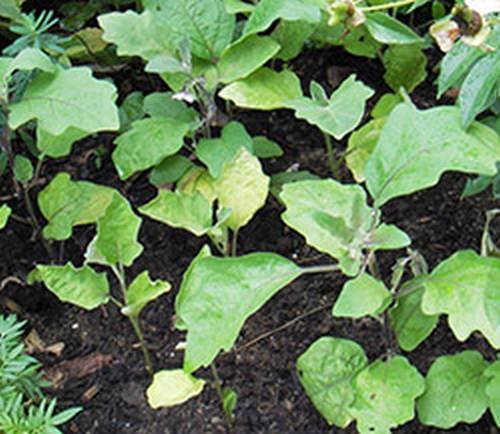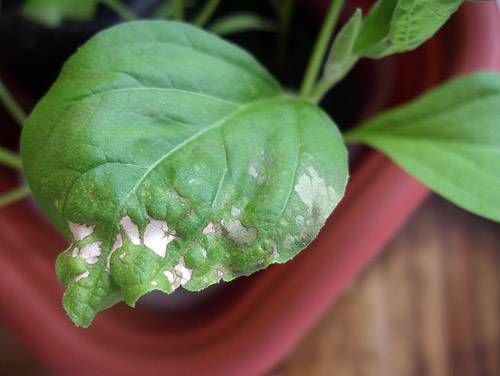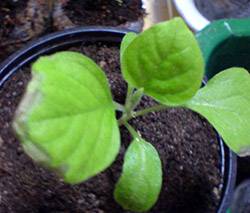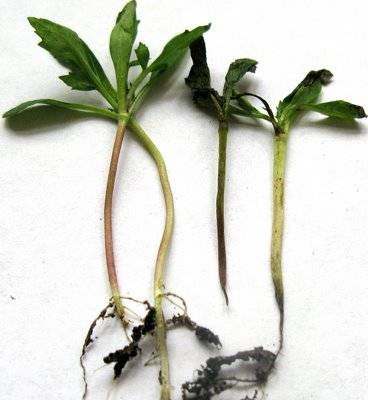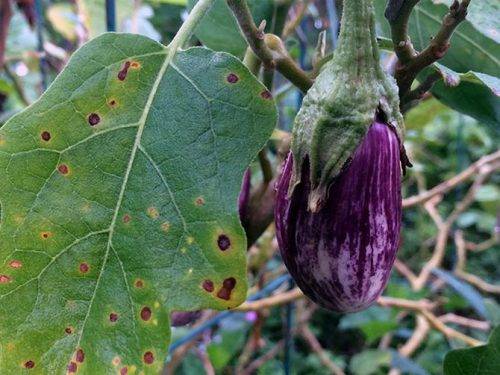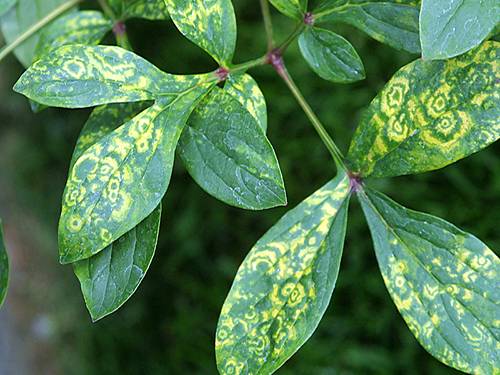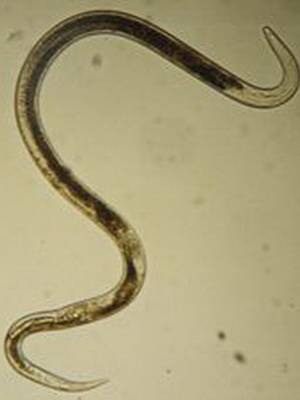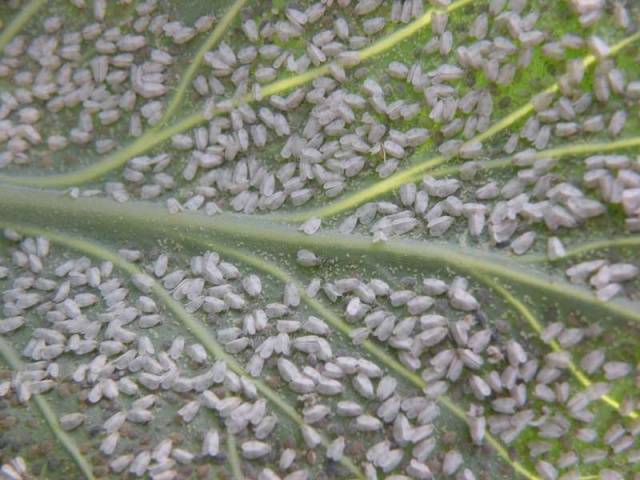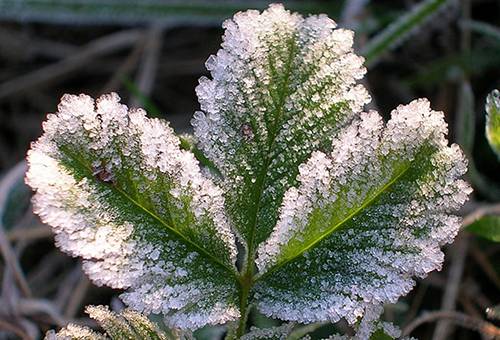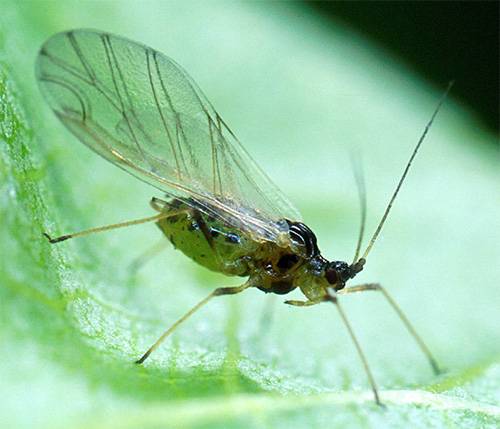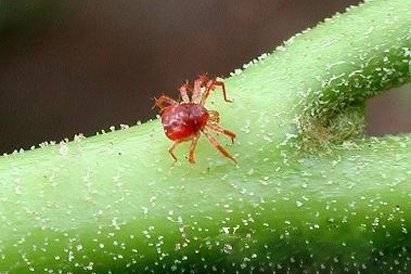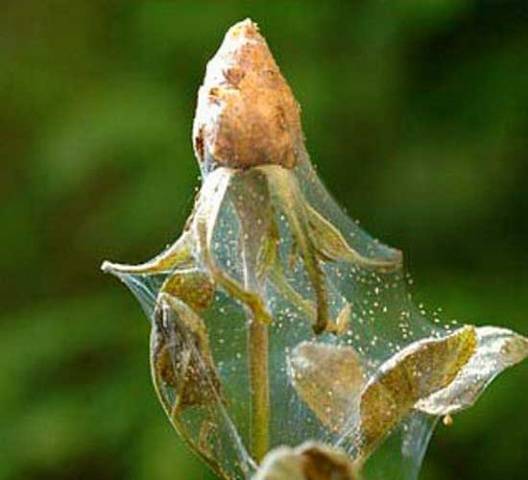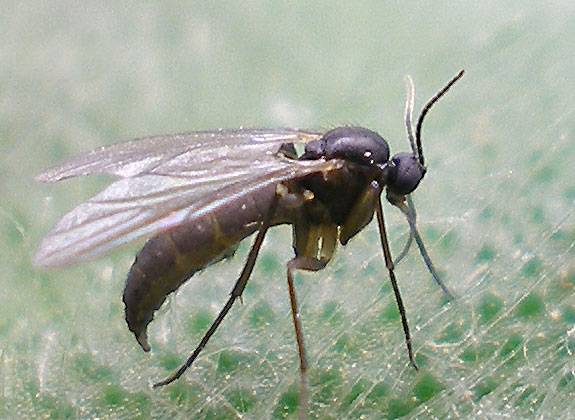Content
- 1 Seed disinfection methods
- 2 Eggplant seeds do not germinate
- 3 Non-contagious eggplant diseases
- 4 Infectious diseases of eggplant seedlings
- 5 Eggplant Infectious Diseases
Eggplants are more delicate plants than their relatives, peppers or tomatoes, and growing eggplant seedlings is much more difficult than any other garden crop. Eggplant seedlings can get burned even from a lamp that illuminates them in order to extend the daylight hours for plants.
The "torment" of the gardener begins almost from the moment of buying soil in a store or making a potting mixture on his own. To begin with, before sowing eggplant seeds, you need to disinfect the soil. Even when buying a ready-made mixture in a store, there is no guarantee that you will buy soil free of pathogens. If you prepare the mixture yourself, it will most likely contain either a pest or an infection.
To disinfect the soil from pathogens, the soil can be abundantly shed with a solution of potassium permanganate. An even better option would be to ignite the soil mixture in the oven. This will destroy not only bacteria, but also multicellular organisms that can subsequently damage eggplant seedlings. During disinfection, beneficial bacteria will also die, but there's nothing you can do about it.
After preparing the soil, it is the turn of the eggplant seeds. They also need to be disinfected, unless the packaging indicates that the seeds have already passed this procedure. The pelleted seeds also do not need disinfection.
Seed disinfection methods
In a domestic environment, you can use one of two methods: disinfection with hot water and disinfection with a two percent solution of potassium permanganate.
Potassium permanganate solution
Eggplant seeds are disinfected for 20 minutes in a 2% solution of potassium permanganate. A solution with such a concentration of potassium permanganate is black, since for its preparation you will have to take 2 g of potassium permanganate crystals per 100 ml of water.
In addition, a weaker solution will not give the desired effect. Eggplant seeds will also turn black after bathing in the solution. After disinfection, the seeds are washed, dried and sowed.
Hot water
When disinfected with a solution of potassium permanganate, only those pathogens that are on the seed shell die. If the seed is infected inside, potassium permanganate will not work. Therefore, a more reliable way of disinfection is heat treatment of eggplant seeds.
In domestic conditions, such heat treatment can only be carried out with hot water. With severe heat treatment, seed germination decreases and it is shown only for seeds in which the loss of germination occurs more slowly than the destruction of the infection. Eggplant seeds are also among these seeds.
It should be borne in mind that when disinfected with hot water, weak, infected eggplant seeds will probably die. But why are they needed, one asks. Healthy and viable seeds will withstand the procedure.
Eggplant seeds are placed in a bag and immersed in a thermos with water, the temperature of which is 50-52 ° C. For eggplant seeds, the holding time in a thermos is 25 minutes. Immediately after the time is up, the seeds are removed and placed in cold water.
Failure to comply with the conditions in one direction or another will lead to the death of eggplant seeds either from temperature or from a surviving infection. But if the conditions are met, this method gives a 100% guarantee that you have only healthy and safe eggplant seeds in terms of infections.
After the preparation has been completed, you can start sowing seeds and waiting for eggplant sprouts.
Eggplant seeds do not germinate
Eggplant seeds usually sprout 5-10 days after sowing. Previously, you shouldn't wait for them.
If all the deadlines have passed, and the eggplant sprouts have not appeared, then there may be several reasons for this:
- too low soil temperature. Usually eggplant seeds are germinated at t = 25 ° C. The minimum temperature is 21 °. At a lower temperature, the seeds will not germinate;
- "Swampy" ground. With excessive soil moisture, eggplant seeds do not receive oxygen and "suffocate";
- too deep seeding. This can even happen by accident if the soil is watered after sowing the seed, and not before;
- sown eggplant seeds processed by the producer. Inlaid and coated seeds germinate later than usual.
Eggplant seeds have sprung up, and other concerns await the gardener. The seedlings can get sick. Diseases of eggplant seedlings can be divided into infectious, capable of infecting neighboring plants, and non-infectious, caused by external, relatively easily eliminated factors.
Non-contagious eggplant diseases
Usually caused by excess or lack of moisture, light, or minerals.
Eggplant seedlings stopped growing
There can be two reasons:
- plants stopped growing after picking... Eggplants do not tolerate transplanting very well, so they can stop growing after transplanting them into personal pots. It is best to immediately sow the eggplant seeds in separate containers. If you had to carry out a pick, you need to water the transplanted eggplant seedlings with a stimulant for the growth of the root system;
- lack of space... Growth stagnation can also occur in eggplant seedlings in separate pots. It is most likely that there is not enough space for the sprout. You can verify this by pulling one plant out of the container and carefully examining the roots. If the roots are brown, then the reason is precisely in the cramped pot. It is necessary to transplant eggplant seedlings into larger containers (+ 2-3 cm) by transshipment, adding soil.
Both problems, although unpleasant, are not dangerous to the plant.
Eggplant seedlings wither
You should not worry if the eggplant seedlings drop their leaves, standing in the sun during the day (no, not to the state in the photo), and fully recover during the night, then this is a normal reaction of plants to the heat. Problems begin when eggplant seedlings do not recover overnight with watering and normal weather. There may be several reasons that eggplant seedlings wither.
Waterlogging and soil acidification
Occurs with too abundant watering, the soil acquires a musty smell. Eggplant seedlings need to be transferred into larger containers, adding soil, and watered more often, but little by little.
"Cold feet"
Too much difference in temperature between the aboveground part of the eggplant seedling and its root system. This happens when the seedlings are on the windowsill, and cold air from the street blows from the window slots, cooling the pots. The ground part under the hot sun rays falling through the glass actively evaporates moisture.The cooled root system does not keep up with them. The result is an imbalance and the eggplant withers.
The issue can be resolved either by raising the pots above the windowsill by 20 centimeters and thus equalizing the temperatures, or by qualitatively gluing the window slots.
The roots of the seedlings suffocated
Eggplant seedlings may wilt if planted in too dense soil, clogged or missing drainage holes, too much water, or if eggplants are planted too close together. The latter concerns the total capacity for seedlings.
To eliminate it, it is enough to loosen the top layer of the soil, punch, clean or expand the drainage holes and reduce the amount of water for irrigation.
Hypothermia of eggplant seedlings
From the cold, the seedlings wither to the state of "rag". This can happen when eggplant seedlings are taken out into fresh air before being planted in a permanent place. The consequences are eliminated by watering the plants with warm water at a temperature of 30 °.
The lower leaves of the eggplant began to turn yellow
In animals, this situation would be called vitamin deficiency. Eggplant seedlings lack nutrients in the soil and for further development it begins to suck them out from the lower leaves. Usually, a similar situation occurs when growing eggplant seedlings in peat. Eliminating the situation is quite simple: the eggplants must be fed with complex fertilizer.
The lower leaves turn yellow even with a lack of nitrogen. This is also eliminated by fertilizers. Seedling leaves can turn yellow due to some infectious diseases or pest attacks. Pests are relatively easy to notice, but before starting to treat eggplant seedlings for an infectious disease, it is better to first add fertilizer and see if the situation improves.
Light spots on the leaves of eggplant seedlings
When such spots appear, you must first of all make sure that there are no pests. If no one is found, then these are burns from the sun or the lamp under which the eggplant seedlings are placed.
It is quite simple to eliminate the cause: rearrange the lamp further away, and shade the eggplant seedlings with newspaper or tulle from the sun.
The edges of the eggplant leaves turn yellow and dry
This situation occurs when there is a shortage of potassium in the soil. The issue is solved by the introduction of potash fertilizer into the soil. True, if recently the seedlings have already been fed, then a similar phenomenon is possible due to an oversupply of fertilizer.
Infectious diseases of eggplant seedlings
Root collar rot
In the first place among the diseases of seedlings is the so-called "black leg", another name for which is "rot of the root collar".
This is a bacterial disease, the main cause of which is the high humidity of the earthen coma. With a black stem, a constriction appears on the stem, separating the roots from the upper part. By this time, the roots and the underground part of the plant have already had time to rot.
In case of infection of seedlings with rot of the root collar, diseased plants are destroyed. If the seedlings grew in a common container, the entire crop will have to be destroyed.
The most reliable method of preventing blackleg is calcining the soil before sowing the seeds.
Black bacterial spot of eggplant
It affects eggplants at any stage of the growing season. The pathogen remains in plant debris and seeds. For this reason, for subsequent sowing, seeds should only be taken from healthy plants and do not forget to dress the seed before planting.
On seedlings, the disease will look like the appearance on the leaves of many small black dots with a yellow border. As with any other similar infection, control measures are to prevent the disease. It is no longer possible to cure the plant.It is necessary to destroy diseased shoots and change the ground if the seedlings grow in a common container.
Eggplant seedling mosaic
Leaf mosaic can be caused by three different viruses: tobacco mosaic virus, cucumber mosaic virus and speckled mosaic virus.
In all three cases, yellow spots appear on the leaves, which gave the viruses the name "mosaic". The leaves look variegated, as if folded from pieces of a mosaic. The virus is transmitted through the soil, where it persists due to the presence of plant debris and insect pests: aphids, ticks, sciarid larvae.
There is no cure. Prevention measures include the destruction of plant debris and pest control.
Eggplant Infectious Diseases
Simply put, pests. Seedlings growing indoors are unlikely to be dangerous pests such as the Colorado potato beetle or locusts, but there are those who are able to penetrate even a city apartment. And sometimes they are brought in from non-disinfected soil.
Nematodes
Nematodes are very small round worms that are almost invisible to the naked eye. They are only 1 mm long. There may be three types of nematodes on the seedlings. All of them enter the plant through contaminated soil, which explains the requirement to calcine the soil before planting seeds in it. Nematodes do not tolerate high temperatures very well. At a temperature of 40 degrees, they die. But the interval 18-24 ° C is comfortable for their life.
Nematode eggs can be stored in seeds. They die during thermal disinfection.
Leaf nematode, in addition to the harm caused by herself, she also carries viruses, including those that infect plants of the Solanaceae family. Signs of its presence: leaves with randomly scattered dry spots.
Stem nematode affects not only stems, but also buds, leaves, flowers. The toxins released by it clog the channels, causing tissue to thicken. The plant stops developing and eventually dies. The stem nematode enters the plant through the roots.
Gall or root nematode parasitizes on plant roots. In the affected areas, swellings are formed, which initially have a yellow, and then brown, color. Due to the thickening, the roots cannot function normally and the plant stops receiving nutrients.
Of all the above, the root gall nematode is the most dangerous, since it can spread not only through the soil, but also through pots, implements, and even through drops of water flowing down from a diseased plant.
Unfortunately, the only really effective means of fighting nematodes is the complete destruction of diseased plants. Contact poisons have little effect. And if the nematode gets into the ground in the garden, it will be impossible to get it out of there.
Whitefly
This insect, in an adult state, looks like a very small white butterfly up to 1.5 mm in size. Whitefly is able to reproduce very quickly, while being active all year round. The eggs are laid on the back of the leaves, protected from the sun. It feeds on plant juices, the leaves because of this insect begin to discolor and lose their shape. Eventually, the leaves fall off along with the buds.
Signs of the appearance of a whitefly on seedlings are a black bloom on the lower leaves, which occurs due to the fact that a sooty fungus settles on the sugary feces of the whitefly. In addition, if you touch a seedling leaf with your hand, a flock of these insects will rise from under it. The whitefly is very mobile. If there are plants in the next room, she can move there too.
Folk remedies against whitefly are effective with a small number of plants in the house. In the case of growing seedlings, it is easier to use insecticides, which will also have to be applied more than once.
Aphid
Aphid queens have wings, so they can easily fly even into an apartment and lay eggs on seedlings. It feeds on aphids with plant sap. Just as in the case of the whitefly, a sooty fungus settles on the feces of aphids.The tops of plants and leaves curl up, later turn yellow, signaling the appearance of aphids. Aphids are capable of carrying viral diseases.
The most effective aphid control is an insecticide.
Spider mite
It also feeds on plant juices. If a cobweb appears on the seedlings, it means that the seedlings are affected by a tick. Dry air is a favorable condition for the development of a tick. It is enough to monitor the humidity of the air, if necessary, spraying water from a spray bottle over the seedlings so that the mite never appears.
If the tick does appear, you will have to use insecticides, carefully treating all the plants. The treatment will need to be carried out several times at intervals of one week until it becomes completely clear that the tick has been destroyed.
Sciarids
Another name is "mushroom gnats". Black-gray midges that breed in organic-rich environments. The flies themselves are not dangerous, their larvae are dangerous, which can damage the roots of seedlings. Any insecticide up to "Dichlorvos" is suitable against sciarids.
Features of growing eggplants, seedlings, diseases and pests
If you managed to successfully grow eggplant seedlings before they are planted in the ground, then new unforgettable adventures await you. Regardless of whether you are planting eggplants in a greenhouse or in open-air beds.

